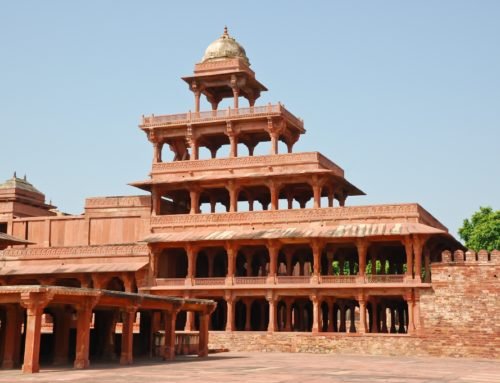Overview
- Features: Sacred section of Fatehpur Sikri with mosque & tombs
- Opening Times: Dawn to dusk, daily
- Best Time to Visit: Early weekday mornings
- Duration: 30 mins to 1 hr
- Travelled By: Bus
- Cost: Free
- Address: Fatehpur Sikri, Uttar Pradesh, India
- Type: Mosque
Author Reviews[display_rating_item_results rating_form_id=”2″ rating_entry_ids=”1″ show_category_filter=”false” show_options=”true” result_type=”star_rating” preserve_max_rating=”true” show_title=”false” show_count=”false” ]
Total Rating: [display_rating_result rating_form_id=”2″ show_count=”false” show_rich_snippets=true] [accordions load=”1″] [accordion title=”User Reviews” last] [display_rating_item_results rating_form_id=”5″ show_options=”true” result_type=”star_rating” preserve_max_rating=”true” show_title=”false” show_count=”true” show_rich_snippets=true] [/accordion] [accordion title=”Add Review”][display_rating_form show_email_input=”true” show_comment_textarea=”true” show_name_input=”true” rating_form_id=”5″] [/accordion] [/accordions]
Summary
The Jama Masjid in Fatehpur Sikri is one of the largest mosques in India built by the Mughal emperor, Akbar in 1571 in Indo-Islamic style. The grand open mosque towers over the city of Fatehpur Sikri and served as a model for several Mughal mosques. This is the sacred section of Fatehpur Sikri and this beautiful and immense mosque is still in use today.
Jama Masjid Fatehpur Sikri
Entrance Gates
The main entrance, at the top of a flight of stone steps, is through the spectacular 54m-high Buland Darwaza (Victory Gate), built to commemorate Akbar’s military victory in Gujarat. Although this is the entrance used by visitors to the Jama Masjid today, the entrance used by Akbar was the Badshahi Darwaza (King’s Gate) to the east which also leads to the palace complex. The steep steps of this royal gateway led Akbar to a view of the sacred mosque directly across the courtyard upon his entry.
Tomb of Sheikh Salim Chishti
[singlepic id=717 w=720 h=560 float=center]
Once inside the courtyard, the most important site is the stunning white-marble tomb of Sufi saint, Sheikh Salim Chishti who predicted Akbar would have a son. The Gujarati-style marble serpentine ‘S’ brackets, infilled with jali, are highly decorative while the carved pillar bases and almost transparent lattice screens are stunning pieces of craftsmanship that surround the inner tomb. The superb marble screens enclosing the veranda were added by Jahangir’s foster brother in 1606. Around the entrance are inscribed the names of God, the Prophet and the four Caliphs of Islam. Completed in 1581, the tomb is entered through a door made of ebony. The shrine inside, on the spot of the saint’s hermitage, originally had a red sandstone dome, which was marble veneered around 1806. The walls of the tomb chamber have brightly coloured flower murals while the sandalwood canopy over the tomb is decorated with mother-of-pearl.
Ever since Akbar’s childlessness was ended by the remarkable prediction of Salim Chishti in 1568, the saint’s tomb has attracted crowds of supplicants, particularly childless women in search of a miracle. Visitors to the dargah, lavishly endowed by both Akbar and his son Jahangir, make a wish, tie a small cotton thread on the screen around the tomb, and go back confident that the saint will make it come true.
To the right of the tomb lie the gravestones of family members of Shaikh Salim Chishti and nearby is the entrance to an underground tunnel (barred by a locked gate) that reputedly goes all the way to Agra Fort! Behind the entrance to the tunnel, on the far wall, are three holes, part of the ancient ventilation system. You can still feel the rush of cool air forcing its way through them.
Mosque
[singlepic id=740 w=720 h=560 float=center]
The oldest place of worship here is the Stone Cutters’ Mosque (circa 1565) to the west of the Jama Masjid. It was built near Sheikh Salim Chishti’s cell which was later incorporated into it by stonecutters who settled on the ridge when quarrying for the Agra Fort began. It has carved monolithic ‘S’ brackets to support the wide sloping eaves.
In the northeast corner is the Jamaat Khana Hall and next to this the Tomb of the Royal Ladies on the north wall. The square nave carries the principal dome painted in the Persian style, with pillared aisles leading to side chapels carrying subsidiary domes. The mihrab in the centre of the west wall orientates worshippers towards Mecca. The sanctuary is adorned with carving, inlay work and painting. Symmetrically flanking the main mosque are pair of identically cloistered prayer rooms with flat-roofed pillared galleries that run round the complex.
Just east of Shaikh Salim Chisti’s tomb is the red-sandstone tomb of Islam Khan, the final resting place of Shaikh Salim Chisti’s grandson and one-time governor of Bengal.





